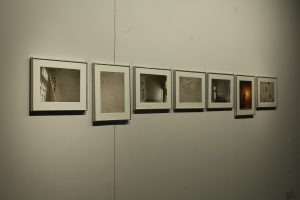Where in the World (2008-09)
Story of the Making
Devi Art Foundation was clear in its agenda of not succumbing to a formula and working with different structures, challenging itself and the counterparts at the same time. For the second exhibition, Devi Art Foundation engaged with a group of students from Jawaharlal Nehru University, New Delhi. The students were to study Curation for an entire semester, which presented as the perfect opportunity to open up the collection and invite the young minds to assess, study, assimilate and view the works in a different light. Students familiarised themselves with the works and prepared individual themes, over months. The themes ranged from the likes of Cabinets of Curiosity, Fetishes, Sex and Dream etc. Eventually a unique narrative of examining the impact of globalisation and economic liberalisation on contemporary art in India came about. Prof. Kavita Singh, Prof. Naman Ahuja and Prof. Shukla Sawant, were engaged throughout, theorizing and guiding the curation along with the students. Interestingly, the title ‘Where in the World’ had come from Prof. Kavita Singh thinking aloud, “Where in the world could such a project happen”! The show was on display at Sirpur House, Gurgaon.
Highlights:
– “This exhibition uses the Lekha and Anupam Poddar Collection of contemporary Indian art to enquire into Indian contemporary art’s circulation across the globe and its relationship with the worlds, here and elsewhere, in which it is made and seen. Through its narrative, this exhibition tries to trace art’s social presence as it addresses new audiences and tries to make itself intelligible to them; uses shock-aesthetics to startle jaded viewers into some form of response; raises consciousness about social issues; or finds itself turned into a desirable commodity, or resists commodification.” – Kavita Singh (Associate Professor School of Arts and Aesthetics Jawaharlal Nehru University November 2008.)
– The exhibition had four sections namely: Export, Outraged, Outrageous, Uncollectable.
– The four sections of the exhibition explore four themes; unlike most thematic exhibitions however, artworks are not grouped together here by their subject matter: viz. landscape-still life-portrait or even gender-environment-identity. Instead, this exhibition tries to trace the ways in which art responds to its new audiences and markets; espouses or eschews identity politics; or tries to rise up within or rise above the market.
– EXPORT: This section of the exhibition suggests that there are many, and more complicated, relationships between location and mobility in the works of well-travelled artists from India. Through the past few years of global visibility, the expectation that art from India will look ‘Indian’ has become not just a formula to be followed, but is a field for artists to explore. Some artists do turn local motifs into spectacular objects that are both familiar and strange to all their viewers. Other artists might mock the audience’s expectation of Indian-ness by offering viewers a bewildering oversupply of it. Yet others might offer enigmatic doses of too little information, piquing curiosity that they refuse to satisfy, leaving the audience unsettled and conscious of their lack of knowledge. And yet others make themselves resolutely un-Indian, and un-locatable, through the visual language they employ.
– OUTRAGED: One way for art to intersect with the larger world is through an engagement with social and political issues. This section considers works that do so, often expressing outrage at the state of the world. Frequently this art reframes issues that we have already received through news media. What does it mean to make a comment, however perceptive, through an artwork, which will be viewed in the limited circuits of the art world? The most persuasive argument suggests that art allows for a slower, more reflective dwelling on the issues that flash past us in the mediascape. In that sense, while the media may offer us information on crises, art can fill the information with meaning. Art of this kind seems to arise from and speak to local issues. But it also travels and is translated into new viewing situations where the meanings that it produces keep shifting.
– OUTRAGEOUS: Since the 1960’s counter-cultural movements in Japan, Europe and the USA have produced works of art or anti-art calculated to shock the public. Artists purposefully make works that are subversive, sacrilegious, sexually graphic, or physically dangerous to artists and/or viewers. Artists claim that this kind of work forces society to confront its taboos and its conventional understanding of right and wrong. More cynically, it is also suggested that this art is pure sensationalism, and is calculated to draw attention in an overpopulated art world. This may even be true of the art of shock from the last ten years, which seems not to resist commodification, but to attract it. This section essentially deals with conversations surrounding this.
– UNCOLLECTABLE: Globally as the art market has grown, some artists have also sought to make art that was impossible to commodify. Performance art, happenings, conceptual art, site-specific art and installations tried to turn art into an experience that left no material trace, or was too unwieldy to be bought. Within some years, however, artists became interested in the expressive potential of new genres, but not the politics that had led to their formation. By the time new genres came to India, installation had already turned into sculpture in an expanded form; performances and events were being captured in photographs or videos which were sold as limited edition artworks; and site specific works were commissioned for museum forecourts and sculpture gardens. This final section of the exhibition uses a range of artworks and art-documentation to look at issues of collecting, not collecting and uncollectability. Collecting, rather than the market, is foregrounded here, because art is able to enter the market only when it takes a collectable form. And collecting – in a relatively stable, public institution – does not simply consume art, but assists in the formation of canons; collections make histories of art possible. What is not collected, very possibly, will be forgotten.
Participating Artists:
A Balasubramaniam, Atul Bhalla, C. Nannaiah, Sheba Chhachhi, Krishnaraj Chonat, Nikhil Chopra, Atul Dodiya, Anita Dube, Nicola Durvasula, Sheela Gowda, Probir Gupta, Shilpa Gupta, Subodh Gupta, Sonia Jabbar, Bharti Kher, Sonia Khurana, Susanta Mandal, N. Pushpamala, Jeetander Ojha, Jagannath Panda, Srinivasa Prasad, Ashim Purkayastha, Gigi Scaria, Mithu Sen, Tejal Shah, Sudarshan Shetty, T.V.Santhosh, and Navin Thomas
















